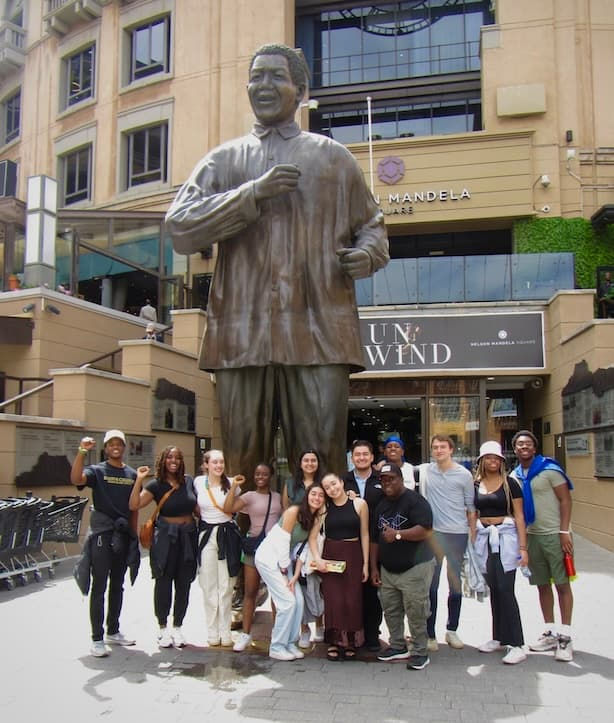Sophia Shaheen ’26

Sophia Shaeen, crouching at center, with fellow students in South Africa.
Arrupe South Africa: Reflections on Racial Justice
At the beginning of this month, I embarked on a nearly day-long flying journey, marking the beginning of my Arrupe International Immersion experience. When we landed in Johannesburg, the warm night air greeted our exhausted but excited group. After four months of preparation, our group of twelve students in the Arrupe Racial Justice cohort was finally in South Africa. Leading up to immersion our group met weekly, educating ourselves, reflecting, and discussing issues of racial identity, faith, privilege, and history. The Arrupe Program aims to connect students to marginalized communities and provide them with the resources to bridge Boston College with the pursuit of social justice all over the world.
We had the opportunity to travel all around Johannesburg and Soweto—the largest township in South Africa—from the Jesuit Institute where we learned of faith-based efforts in social justice to the Regina Mundi Church filled with a haunting history and beautifully echoing hymns. Our group was welcomed with open arms by our wonderful guides and host families, by the beautiful older women at church singing, dancing, and ushering us into the pews, by the smiles and waves of strangers on the side of the road, and by the rain and hail that fell almost every day—a symbol of good fortune in South Africa.
This encounter filled me with such joy, but gaining a deeper understanding of South Africa’s historical and ongoing struggle with racial justice and segregation was profoundly sobering. As an outsider looking in, the systemic barriers and racism are apparent in something as simple as the landscape or the neighborhoods we passed. The lush forests and sprawling countryside were framed by huge, unnatural mountains. These towering mounds are the result of South Africa’s immense mining industry, rooted in the exploitation of black South Africans. These mountains rushed by the windows of our van as we drove through one of the poorest neighborhoods in South Africa. As we continued to drive, the infrastructure changed drastically as we entered one of the wealthiest neighborhoods in the continent of Africa, only mere minutes away from extreme poverty. Like most places in South Africa, these socioeconomic divisions almost directly correlated to race due to the powerful legacy of Apartheid.
One of the most impactful experiences of the Arrupe trip for me was hearing from a member of the 1976 Soweto Uprising, a series of protests led by black students fighting against Apartheid’s education policies. As rain sprinkled down on us, Mama Antoneitte stood in front of our group and recounted the fateful day her twelve-year-old brother, Hector Pieterson, was killed in a demonstration. Despite this tragic day, she continues to exude light in her contagious smile and laughter, and in her deep love for her community and country. We were inspired by her courage and determination to keep her brother’s legacy alive and fight for racial equality even decades after his passing.
I learned from my homestay family that many try to deny the current issues of systemic racism in South Africa, claiming that discrimination and segregation disappeared with the dismantling of Apartheid in 1994. In truth, many South Africans—like Mama Antoneitte—can still recall a time in their lives when Apartheid ruled society. While the end of Apartheid represented a crucial step toward ending discrimination, it did not erase racism and its detrimental effects on the lives of black South Africans. In fact, many socioeconomic disparities have even worsened in the post-Apartheid era.
As we walked around the malls, biked through neighborhoods, and drove through the city we remained mindful of the inequalities that exist in so many facets of society in South Africa. Moreover, we also became hyper-aware of our own identities in the racial and historical context of the country. It becomes easy to focus solely on the injustices happening in Johannesburg, but these discriminatory practices are echoed heavily in systemic issues of the US. Indeed, there is much we can learn from South Africa in the ways they choose to move forward as a country through remembrance. On immersion, I learned of the Sankofa bird, a West African image of a bird with its body facing forward and its head turned backward. In many ways, this symbol represents South Africa’s knowledge that we cannot move forward without constantly looking back to history.
Hope is something that I saw in the eyes of so many during immersion. As we were asked to recall our international encounters at the Arrupe Post-Immersion Reflection, I thought immediately of the beauty of Johannesburg and the South African people. Their painful history is buried deep in their lives and in the winding roots of their country, yet, despite this, they have been able to find love in everything and everyone. Their sense of community is wonderfully unique and overwhelming, as the strangers we met pulled us into their circle of joy without hesitation. Our group took this warmth into our own pursuits in learning, reflecting, and bonding with one another. Every thoughtful conversation, heated game of cards, and fit of uncontrollable laughter brought us closer together. I am filled with gratitude for this incredibly enriching and transformative opportunity, and for the people I now consider family.
January 2024

